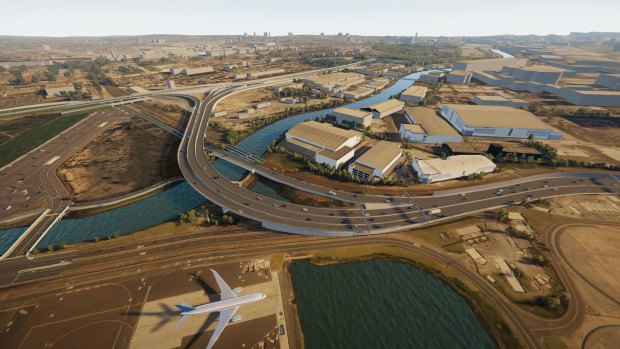Construction of a $2.6 billion motorway extension to Sydney Airport is predicted to cause delays for motorists driving to the international and domestic terminals, and poses a potential distraction to pilots landing at the main runway.
The so-called Sydney Gateway will extend from an interchange for the WestConnex toll road at St Peters to the airport's domestic and international terminals at Mascot, and closer to Port Botany. Construction is due to start by mid next year and be completed by 2023.

An artist's impression of the new motorway from Sydney Airport to an interchange for WestConnex at St Peters.
An environmental report, released on Wednesday by the NSW government, warns that substantial works will be needed on existing roads around the airport to build the motorway, forcing the closure of lanes on the busy Qantas Drive and Airport Drive for periods.
Construction will lead to extra congestion and delays for motorists and buses at intersections near the airport, especially those near the domestic terminals, the report shows.
Contractors will carry out short-term road and lane closures at night "as far as possible" to minimise disruption. However, the report warns that the use of cranes will "occasionally require full weekend closures" and traffic detoured to the airport terminals.
Unlike with WestConnex, motorists will not have to pay tolls to use the new motorway. The project will result in a widening of Qantas Drive from two to three lanes in each direction, and include a flyover viaduct from Qantas Drive to the two domestic terminals.
The environmental report warns that construction will lead to "temporary intrusions" into the airport's airspace and high-intensity approach lights for planes landing at the main runway, when cranes and other large equipment are used.
Night-time lighting for construction could also pose a potential distraction to pilots in "some areas".
The report said the temporary intrusions into prescribed airspace would be "minimised as far as possible", and work would be timed to occur during the airport's curfew period at night.
Much of the land needed for the motorway is leased by Sydney Airport, or owned by the federal or state governments, and Inner West Council.
Land used by Tempe Golf Range and an off-leash dog park will be required during construction. The NSW government is offering a temporary area for dogs "as close as possible" to the existing site.
One of the other risks from construction is disturbing contaminated land where a car park is located north of the airport in an area known as the "northern lands".
The project is designed to make it up to 23 minutes quicker for motorists to drive to the airport's terminals by 2026 than using alternative routes through Mascot. Travel times to Port Botany are also forecast to be up to 17 minutes quicker within six years.
Transport and Roads Minister Andrew Constance said the new motorway would have capacity for 100,000 vehicles a day, and provide a new route for trucks.
"This will help remove trucks from Mascot, reduce travel times and congestion, and return local streets to the community," he said.
Sydney Airport, which supports the motorway project, said it would work closely with the state's transport agency to "help minimise traffic disruption" during construction.
"All construction activity will be managed in strict accordance with Civil Aviation Safety Authority regulations that underpin the safe operation of the airport," it said.
The new motorway is budgeted to cost taxpayers $2.2 billion to $2.6 billion. It is a separate project to WestConnex but is needed if the latter is to meet one of its original aims of connecting Sydney Airport and Port Botany to western Sydney.